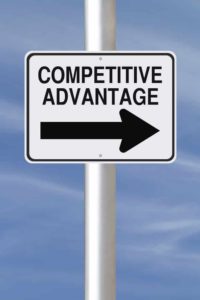Transient Competitive Strategy?

Is it time to rethink what we mean by Competitive Advantage?
Rita Gunther McGrath recently wrote “The End of Competitive Advantage: How to Keep Your Strategy Moving as Fast As Your Business”. The basic idea of a Competitive Advantage is that to be successful, businesses need strategies which position them ahead of their competitors when their target customers think of them versus competitors. The Holy Grail has been “sustainable” Competitive Advantage. For instance, Walmart’s “Opportunity Loop” which focuses on driving down costs and using the savings to increasing lower future prices and encourage more sales to increase profits, rather than simple harvest the increased margins as immediate profits, as most companies do. That strategy, along with other complementary ones, enables Walmart to provide “every day low prices”.
 Her thesis is that it’s virtually impossible to have a sustainable competitive advantage today, because things change too quickly and once competitors learn to copy your Competitive Advantage, it no longer is! To win in today’s world, she believes that companies need to capture opportunities fast, exploit them decisively, and then move on even before they’re exhausted. This constant generation of advantages gives the company a “transient competitive advantages.”
Her thesis is that it’s virtually impossible to have a sustainable competitive advantage today, because things change too quickly and once competitors learn to copy your Competitive Advantage, it no longer is! To win in today’s world, she believes that companies need to capture opportunities fast, exploit them decisively, and then move on even before they’re exhausted. This constant generation of advantages gives the company a “transient competitive advantages.”
She notes that these companies (like Fujifilm and Infosys) carve out more granular “arenas” which connect customers and solutions, rather than tackle entire industries in which offerings can substitute for each other.
We disagree. We believe companies can forge sustainable competitive advantages which we call “Commanding Strategies”; these are long-term strategies that leverage other companies’ weaknesses (even though they may think what they do is a strength!) create a long-term competitive edge. Walmart’s Opportunity Loop is an example. When Kmart in the 1990s tried to compete with it by dropping its sales prices to match Walmart’s, they wrote their ticket to bankruptcy. Why? Because low customer prices only generate profits if its buying/volume sales strategies allow it to buy products at still lower costs. Kmart was selling its products at a loss.
Other companies that have used Commanding Strategies include TD Bank and Apple. TD Bank’s Commanding Strategy of longer hours, 7-days a week, works because they focus on teller services. Not having to use more highly skilled (and expensive) staff to sell other products (as do full-service banks like Chase), allows them maintain a profitable operation on transactions even during non-peak hours. Full-service banks could expand the number of hours to match TD Bank, but not profitably. Similarly, Apple’s Command Strategy of focusing on a well designed ecosystem of software/hardware, rather than low-cost software and/or hardware (e.g., Wintel and PC makers), allows them to obtain pricing premium for its products, such as the iPhone, iPad, etc.
What do you think? Share your thoughts and examples!
Category: Business Growth & Strategy
Tags: Competition, Competitive Advantage, Opportunity, Strategy

